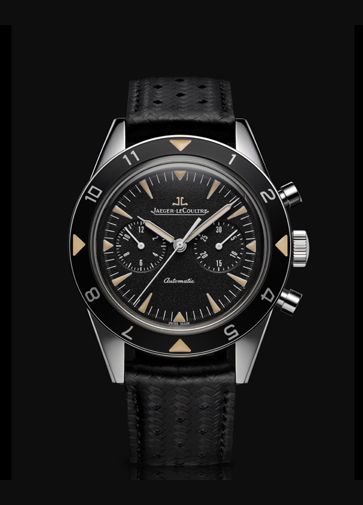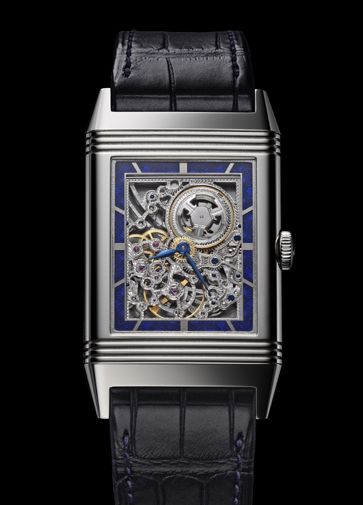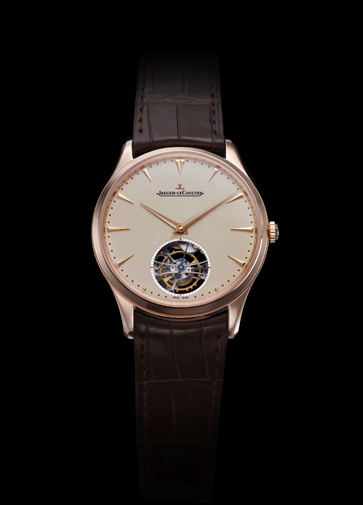-
VISIT THE OFFICIAL SITE OF JAEGER-LECOULTRE
-
HISTORY
Jaeger-LeCoultre represents in Haute Horlogerie what one could call an “ideal marriage”.
Innovation marries endurance.
In several articles from veryimportantwatches.com, I underline that endurance alone, does not add much to the product itself, if it is not accompanied by innovation, an essential quality of Haute Horlogerie.
It is a continuous effort always to be ahead of your time, to push history forward in a professional or artistic field, and this enables a brand to bear the prestigious title of Historical House.
Jaeger-LeCoultre may not be the oldest House in the watchmaking world – even if it was created in 1833 – but there is no risk saying that it is the one which offered the most to the simple watch, as well as to the complicated one.
The motto of the time, so important to the History of Jaeger-LeCoultre, inspired by Günter Blümlein and Henry-John Belmont, “With the eye, the hand and the heart”, gives us a perfect picture of this unique case that is Jaeger-LeCoultre Manufacture, that follows up to today a history punctuated with 1000 different calibres, 300 patents and legendary watches such as the Reverso, Duoplan, Memovox, Polaris, Gyrotourbillon I, or even the revolutionary clock Atmos.
But let’s start from the beginning:
The LeCoultre family settled in the Joux Valley in the 16th century, when Pierre LeCoultre fled from persecutions against the Protestants in France, and decided to settle there after spending some time in the city of Geneva. Courageous and determined to be up to the challenge, he bought a piece of land in the Joux Valley as can be seen in a deed that he signed when acquiring the land that remains a landmark in the history of this region. He lived the rough life of a pioneer, engaged in forest clearance, land work and animal husbandry, but also bear and wolf hunting, as these were numerous in the region at that time. Despite many obstacles and different events, the community started to grow. In 1612 the son of Pierre LeCoultre built a church that marked the settlement of the Sentier village.
The LeCoultre family worked for generations in the small family-run forge and this was where Antoine LeCoultre, genius inventor and founder of Jaeger-LeCoultre, tenth generation since Pierre LeCoultre, built up his knowledge in metallurgy, inventing with his father a new alloy, perfecting music box vibrating blades and setting the basis for the razor blade industry. His curiosity and will to combine his empirical knowledge to scientific culture soon made him turn towards the noblest art in mechanical arts: watchmaking.
The very tough climate in the Joux Valley, at an elevation of 1,000 meters, far from commercial roads and surrounded by passes often closed during long, everlasting winters, definitely contributed to the destiny of this region. Women and men settled on this land to conquer, and knew that survival had a price: ingenuity.
At Jaeger-LeCoultre, inventions were part of the everyday program from the very beginning. The first LeCoultre workshop was created in 1833 when Antoine LeCoultre elaborated a technical achievement, a machine able to cut watch pinions, later adopted by all professionals, like all great discoveries of the House, contributing therefore to the world reputation of Swiss watchmaking.
Years went by, punctuated by multiple inventions such as the Millionomètre (1844), enabling the measurement of microns (thousandth of millimetre), the famous “remontoire à bascule” (1849), the first system able to replace the traditional key for winding and setting the time of a watch or the first complicated movement, pieces for which the manufacture earned the name of “Grande Maison”.
From 1860 to 1900, the manufacture created more than 350 different calibres. Half with complications: 99 repeaters, amongst which 66 minute repeaters, 128 chronographs and 33 calibres that gather in the same timepiece the chronograph and the minute repeater. From 1890, the manufacture presented its firsts Grande Complication, that is to say watches with three majors watchmaking complications: perpetual calendar, chronograph and minute repeater.
In 1903, Edmond Jaeger (1858 – 1922), Parisian watchmaker for the French navy, challenged the Swiss to manufacture ultra-thin calibres. The manufacture’s creator grandson, Jacques-David LeCoultre (1875 – 1948), in charge of manufacturing at LeCoultre & Cie at that time, accepted the challenge. This collaboration, and then friendship with Edmond Jaeger was to give birth to one of the most extraordinary ultra-thin watch collections in the world, with the LeCoultre Calibre 145 (1.38mm thick). This would be followed by pioneering wristwatches that would lead in 1937 to the creation of the Jaeger-LeCoultre House.
From the beginning of the wristwatch, Jaeger-LeCoultre offered many models that quickly attracted the public, and that would later become great classics, passing through decades with reinterpretations coming from the inexhaustible creativity of master watchmakers, as well as the fruitful inventiveness of other artists – enamellers, engravers etc. – working for the “Grande Maison”.
The first was Duoplan that paved the way to the smallest movement in the world, Calibre 101. Born in 1925, Duoplan, was invented to solve the issue of wristwatch precision. Its tiny dimensions compared to pocket watches meant having much smaller balances that lacked precision. The Duoplan movement is built in two “floors”. Therefore, the balance volume is much more important, enabling the watch to be very reliable and precise when measuring time. The watch also provided a unique after-sales service by Lloyd’s in London: every single damaged movement was replaced in a few minutes. The London retailer Tyme proudly stated: “Your watch will be repaired in less time than you need to finish your cigarette!”
In 1929, the most important version of the Duoplan movements’ family, Calibre 101, broke the record of the smallest mechanical movement in the world. Today, with its 98 components (in 1929, there were 74), 14mm length, 4.8mm width and 3.4mm thickness and a weight of hardly 1 gram, this world record is still the reference 83 years later!
The famous clock Atmos is as eternal as it is historic. Invented in 1928 by Jean-Léon Reutter from Neuchâtel, Atmos represents for science one of the rare objects that came close to the old dream of perpetual movement. The complete knowledge of Jaeger-LeCoultre’s watchmakers will be necessary to go from prototype to the Haute Horlogerie clock. Atmos takes its energy from the slightest changes in temperature. A one degree fluctuation is enough to keep it going for two days! It consumes 60 million times less energy than a 15 W bulb! This cult object has remained until today the official gift of the Swiss Confederation for more than half a century.
It is during this golden era of the manufacture, and more specifically in 1931, that Reverso, the iconic watch par excellence of Jaeger-LeCoultre was also introduced. For Reverso, the original idea came from César de Trey, who during a business trip to India, took up the challenge of creating a watch able to withstand the shocks during a polo game. Back in Switzerland, de Trey entrusted the project to Jacques-David LeCoultre, who created Reverso, whose name is inspired by the Latin “I turn over”. A simple gesture makes it possible to swivel the case on its brancard to protect the watch glass. The back of the Reverso was to be available for any personalisation by all means of the art of watchmaking, and the collection continued for decades to celebrate today, younger than ever, its greatest success, both commercial as well as artistic.
The decades following WWII saw the emergence of watches for “active men”: the men who had to rebuild the world. In the field of watchmaking, one speaks about the shock, water and magnetism resistance, chronometric precision, and useful functions such as alarm, calendar, or automatic winding. In 1946, the Calibre 476 was the first automatic calibre of Jaeger-LeCoultre. The automatic movement would be the object of multiple creations for the House up to now: rotor mass, gold mass, one-way winding then bidirectional winding, high frequency, ceramics bids etc…
In 1950, Memovox (literally the memory voice) made it possible to organise our every day time with a ring: alarm clock, meetings, train schedules etc. In 1956, Memovox with Jaeger-LeCoultre Calibre 815 offered simultaneously the alarm clock and automatic winding features.
A unique watch, the Geophysic Chronometer was offered to William R. Anderson, Major of the American nuclear submarine, which on August 3, 1958 reached the North Pole in a tour connecting the Atlantic Ocean to the Pacific by the most direct and fastest way.
The 1990s were notable for the presentation in 1992 of the Master Control collection, where each watch passed a 1000-hour exhaustive test (approximately 6 weeks), as well as the launch in 1991 of the first Reverso with complications, the sublime “Reverso of the 60th”, which was to be followed by a whole succession of other limited rose gold Reverso series: tourbillon, minute repeater, perpetual calendar, retrograde chronograph… In 1994, Reverso Duoface offered for the first time the possibility of having two dials back to back, as well as the indication of two time zones.
This same idea was to be followed by a very beautiful female interpretation of Reverso, the Duetto created in 1997: its recto evokes the time of the day, whereas its crimped back celebrates the hours of the night!…
In the early 21st century – and right after the acquisition of the House by the Richemont Group – Jaeger-LeCoultre exhibited overflowing creativity. Fifty new calibres are the fruit of a mere decade. Among the new calibres one finds watches with grande complication, tourbillons, perpetual calendars, minute repeaters, chronographs, 15-day power reserve, the first calibre without lubricant etc. In the same time, more than 50 patents have been registered to protect inventions in the field of movements, as well as in the field of cases.
With ultra-complicated watches or creations of high jewellery, the complicated Atmos, AMVOX, Master Compressor Diving or Reverso Squadra, Jaeger-LeCoultre is a reference the watchmaking industry.
Another great innovation in the history of watchmaking appeared in 2002 with the presentation of the Reverso Grande Complication à Triptyque, which offered for the first time three dials with the same movement! On its recto, the civil time is marked by an ellipse isometer tourbillon. Its verso offers a zodiac calendar and the equation of time. Its third dial is integrated into its brancard: an instantaneous perpetual calendar is actuated every 24 hours, at midnight exactly.
In 2004, the watchmakers of the manufacture created Gyrotourbillon I, by equipping it with a spherical tourbillon revolving on two axes, a perpetual calendar with retrograde dual indicators and a solar ongoing hour, as well as an eight day autonomy and an equation of time. The assembly of some 679 components, as well as the adjustment of this masterpiece, are entrusted to one and only watchmaker. The spherical tourbillon alone consists of 100 components that hardly weigh a third of gram!…
Throughout the last years, Jaeger-LeCoultre has been producing limited series and watches paying tribute to the great classics of the House, such as, for example, Memovox Polaris, Atmos, or the Deep Sea divers’ watches, as well as, of course, Reverso and watches whose realisation is extremely difficult such as the Gyrotourbillon II, or the triptych of Hybris Mechanica.
Today more than 1000 people, mastering more than 40 different professions or specializations, via a unique industrial infrastructure, invent, design, manufacture, assemble, adjust, set stones, engrave or enamel each day, unique time keepers who illuminate and permanently renew the great Swiss watchmaking tradition worldwide.
And all that, while having only briefly talked about some of most important of creations of Jaeger-LeCoultre, without mentioning any of the historical watches belonging to the Houses of greater fame in the watchmaking industry, which would however house a movement from the Jaeger-LeCoultre Manufacture!...
- VIDEOS
Visit the YouTube page of Jaeger-LeCoultre and watch the videos containing information regarding the company’s products and activities.
-
APPLICATIONS
Discover and enjoy high end technology applications for iPhone and iPad, simply by clicking, HERE.
Visit Jaeger-LeCoultre’s official page on Facebook.
Visit Jaeger-LeCoultre’s official page on Twitter.
- WATCHES
Page 1 of 1 [3 results]




